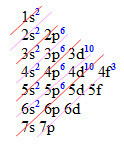if we think in common salts, we will see that they are all solid at room temperature. To mention a few examples, we have sodium chloride (table salt), sodium bicarbonate (used as baking powder, as an antacid, in talcs, deodorants and foam extinguishers), calcium carbonate (composed of marble, limestone, egg shells, shells and corals), among others. All solids and with very high melting points (table salt is approximately 800 ºC).
Previously, it was thought that it would not be possible to have some chemical species in the liquid state with characteristics similar to those of a salt. This conclusion was based on the fact that in this physical state the interactions between the chemical species that constitute the substance (ions, molecules or atoms) are stronger than interactions in the gaseous state and weaker than interactions in the solid state. When a substance is formed by ions, there is a very strong attraction force between its molecules and, therefore, they are usually in a solid state.
This situation of energy balance leads to the fact that the vast majority of liquids are formed by neutral molecules.However, with more detailed studies, it was found that there are liquid salts, which are better classified as ionic liquids, because they are made up of positive and negative ions, but they are different from the sodium cation (Na+) and the anion (Cℓ-) of sodium chloride. Its nomenclature is more complex. Just to cite an example, we have: 1-ethyl-3-methylmidazolium cation.
These ionic liquids contain in a small percentage some characteristics of common table salt.
Ionic liquids can be formed by mixing certain substances together. For example, in the late 1940s, it was discovered that when alkylpyridinium chloride and aluminum trichloride were mixed, an ionic system with a low melting temperature was formed. Over the decades, other discoveries have been made and some more recent examples of ionic liquids are the 1-n-butyl-3-methylimidazolium tetrafluoroborate (BMI.BF4) and 1-nbutyl-3-methylimidazolium hexafluorophosphate (BMI.PF6).
Do not stop now... There's more after the advertising ;)
Ionic liquids have very important properties, such as dissolving such materials. different, such as plastics or rocks, and can also replace chemical solvents derived from Petroleum. In addition, they have a big advantage: they do not evaporate and therefore do not pollute the atmosphere.
Due to these characteristics, ionic liquids have been increasingly used in different fields of knowledge, such as in batteries, in electrochemistry, as solvents for spectroscopic analysis of metallic compounds, solvents in two-phase catalysis, solvents for liquid-liquid extraction, as stationary phase for gas chromatography and as acid solvents and catalysts for reactions organic.
Furthermore, scientists have found that when you mix ionic liquids with traditional salts, you get a salt. with characteristics very similar to traditional salts, but in a liquid state.
Scientists believed that it was not possible to transfer ionic liquids to the gaseous state because the temperatures required for this would cause them to decompose before they change their state of aggregation. As a result, processes such as distillation would not be possible and would not be able to achieve a higher degree of purity.
However, it was found that this can be done for many ionic liquids, as long as low pressures (vacuum) are used. In this way, very pure ionic liquids are obtained that can be used more widely.
By Jennifer Fogaça
Graduated in Chemistry
Salt nomenclature, salt classification, anion name, cation name, iron sulfate, ferrous sulfate, nitrate of silver, potassium chloride, sodium chloride, calcium chloride, silver nitrate, copper sulfate, sodium carbonate calcium.
Chemistry

Everyday salts, calcium carbonate, sodium chloride, sodium fluoride, potassium nitrate, sodium nitrate sodium, sodium carbonate, sodium bicarbonate, sodium bicarbonate, sodium sulphite, saltpeter, soda.



